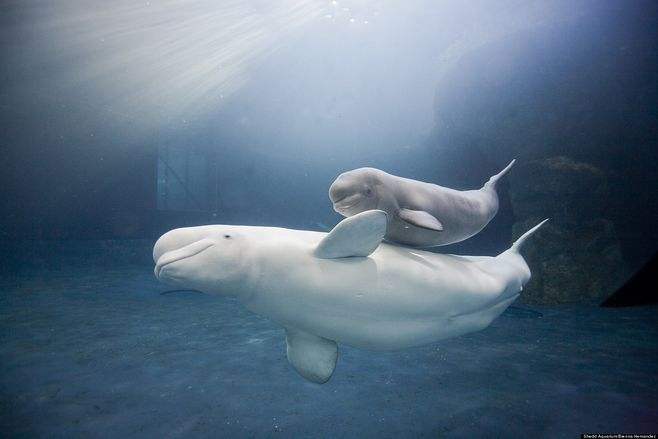Beluga whale
IUCN
LCBasic Information
Scientific classification
- name:Beluga whale
- Scientific Name:Delphinapterus leucas, sea canary
- Outline:Cetacea
- Family:Eutheria Artiodactyls Odontoceti Narwhal Beluga
Vital signs
- length:3-5.5 m
- Weight:1300-1500kg
- lifetime:32-40 Year
Feature
It looks very similar to a dolphin and is very cute. It ranked twelfth on the list of the cutest animals in the world in 2013 and is the cutest whale in the world.
Distribution and Habitat
Beluga whales are mainly distributed along the coasts of Canada, Alaska, Greenland, Norway and Russia in the Arctic and sub-Arctic regions. They mainly live in river entrances, fjords, harbors and warm shallow seas in the Arctic Ocean where sunlight is available all year round. They also appear in estuary waters in summer. The water temperature in their habitats is generally around 8~10℃.
Appearance
Beluga whales are the only whales that are completely white. When they are born, they are gray and gradually turn white as they age. They do not have dorsal fins, but they have a strong back to allow them to move under the ice. Beluga whales have a stout, spindle-shaped body. The body surface may be covered with wrinkles and fat folds, which are particularly obvious on the ventral side. Adult beluga whales are about 3-5 meters long, and can reach 5.5 meters. Males are larger than females, with males averaging 1,500 kilograms and females averaging 1,350 kilograms. Unlike other whales, beluga whales have flexible necks that can move freely, and can nod and turn their heads. There is a thick layer of fat under the skin of beluga whales, which is up to 15 cm thick. The fat acts as a barrier to the cold.
Beluga whales are social animals, often in groups of ten. In summer, thousands of beluga whales migrate to estuaries to feed, socialize, give birth and raise their young.
Details
As the name suggests, it is a white whale. It is called the cutest whale in the world because it looks cute, looks like a dolphin, and is close to humans.

Not only is the beluga whale cute, it also has a relatively high IQ, even comparable to a three-year-old child. Therefore, the beluga whale gives people a very lively and active feeling, and at the same time, the curiosity is also very strong. The beluga whales in the zoo are also very lively and like to play with humans. The beluga whale can understand some instructions and can also cooperate well with humans and follow their arrangements.
Beluga whales are the best "ventriloquist" experts in the whale kingdom. They can make hundreds of sounds, and the sounds they make are varied. In order to understand the sounds of beluga whales, scientists conducted on-site underwater recordings at the beluga whale migration destination in the estuary delta. The results were very unexpected. They heard the roar of beasts, the mooing of cows, the snoring of pigs, the neighing of horses, the squeaking of birds, the screams of women, the groans of patients, and the crying of babies. It was really varied and there was nothing strange. Beluga whales can also make hinge sounds, bell sounds, steamboat sounds, etc. Beluga whales keep "singing", which is actually entertaining themselves, and it is also a kind of communication between companions. This is an important part of their summer migration.
Since the 17th century, due to the high profits of whaling, whalers have hunted beluga whales crazily, causing the number of beluga whales to plummet. Even more tragic is that the ecological environment of beluga whales has been devastated, and batches of beluga whales have died one after another. Scientists found the cause of death after autopsy: due to the invasion of a series of toxic substances, their immune systems were severely damaged. These beluga whales suffered from gastric ulcer perforation, hepatitis, lung abscess and other diseases; what's worse, some beluga whales suffered from bladder cancer, which is unheard of among cetaceans. More importantly, some pollutants have been found in beluga whales, such as polychlorinated biphenyls, DDT and some highly toxic pesticides. Some beluga whales' brain tissues contain a large amount of carcinogenic PAH (polycyclic aromatic hydrocarbons) benzodione that has undergone metabolic changes. This substance has been transformed into part of the gene, causing irreversible damage to the beluga whale's genes.








